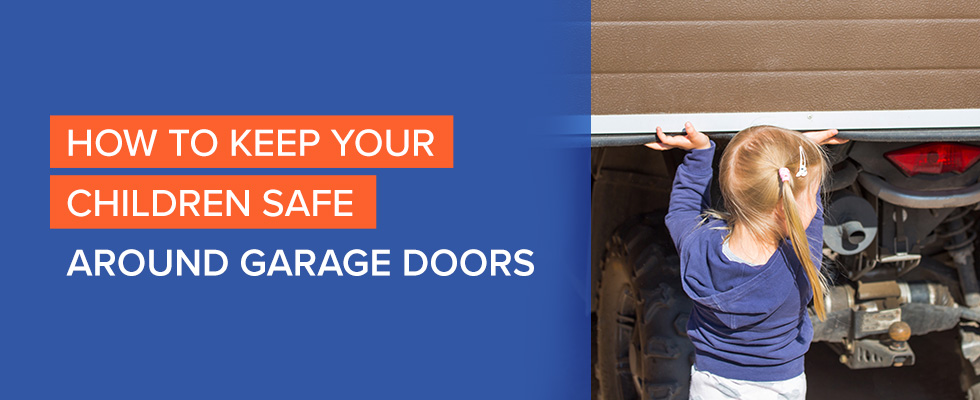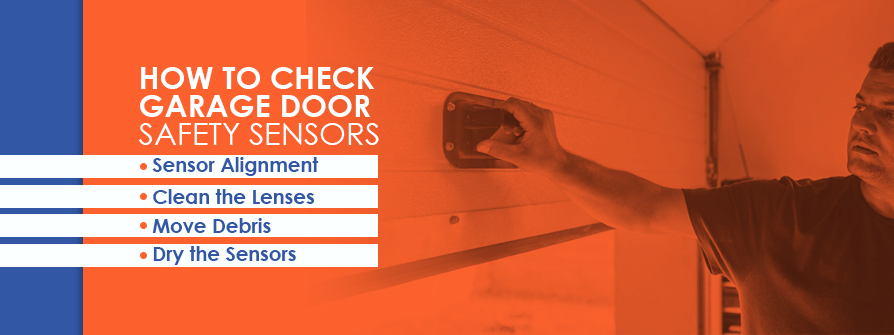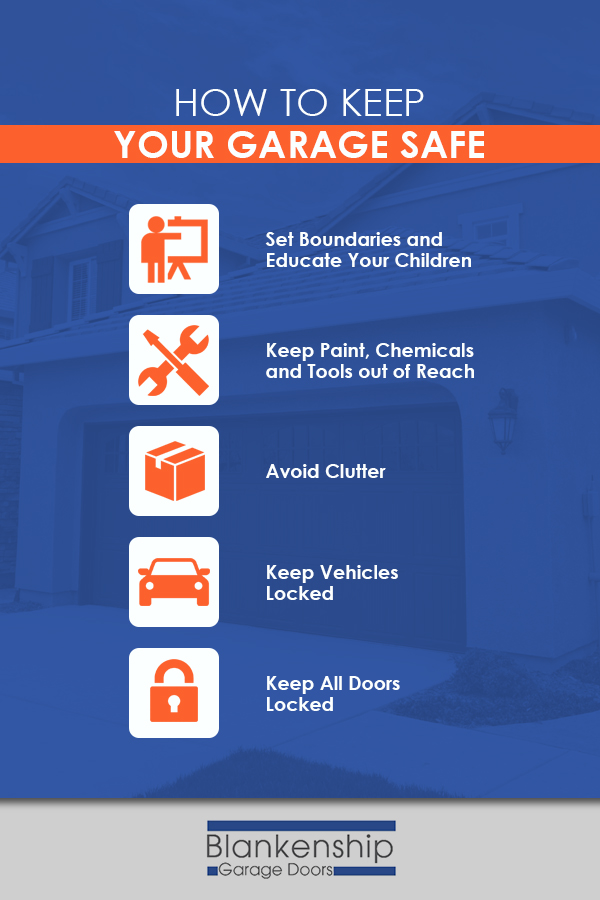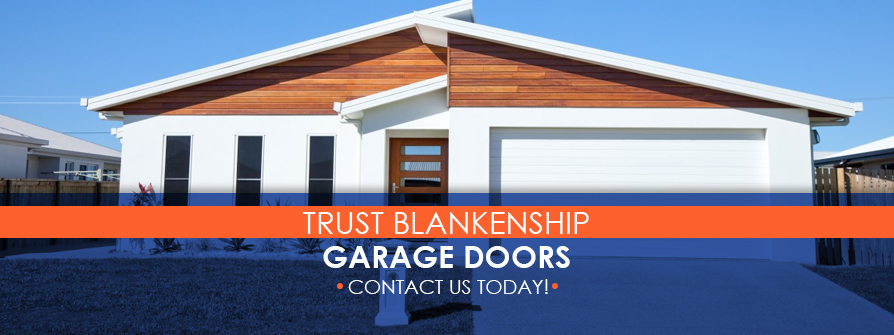HOW TO KEEP YOUR CHILDREN SAFE AROUND GARAGE DOORS
When your child was born, you probably went a little crazy covering electrical outlets, locking kitchen cabinets and placing cleaning products high out of reach. Every parent knows the basics of childproofing their house, but when was the last time you thought about childproofing the garage? It’s easy to overlook garage safety precautions when you’re thinking about your child. After all, it’s not like they play in there every day, right? If you haven’t considered your garage door to be a safety hazard, you aren’t alone. In fact, 82% of Americans admit that they tend to neglect maintenance and safety when it comes to their garage door.
The truth is that your garage — especially the garage door — presents a number of potential dangers for children. Just because their toys aren’t out there or their playroom is on the other side of the house doesn’t mean that their curious minds won’t lead them into the garage when you aren’t looking. Just as you childproof your house, it’s important to take a few minutes to find and eliminate dangers your children may face in the garage. Where should you start? Here are garage door child safety tips to keep in mind.
TYPES OF GARAGE DOOR SAFETY HAZARDS
It’s vital to understand your garage door and how it works, plus how it may fail to mitigate sudden injury. The most common door injury kids face is pinched fingers, but injuries can also be worse. Here are the various types of garage doors and the risks they may carry:
- Panel garage doors: These doors consist of hinge-connected panel sections that can pinch fingers if someone tries to catch the door while it’s moving. Panels could also fall off if not installed correctly, posing injury risk.
- Barrel-roll garage doors: Hands or fingers can get caught in the steel roll if someone tries to grab the door from the inside while it’s moving. If unbalanced, the door can quickly descend and cause injury.
- Parallel-slide garage doors: These doors run along a bendable track and slide sideways to open. Debris or small objects can jam the track, causing sudden halting, which can lead to injury if someone is near. If a child is playing nearby, the door can also push them aside.
- Lateral pivot garage doors: These models resemble large barn doors and swing outward to open. A child standing too close may get hit by the door as it swings open. Plus, the hinges can pinch fingers if kids’ hands are too close during movement.
- Lift and project canopy garage doors: These doors tilt outward and are pushed up into the ceiling of the garage. If someone stands too close when the door is activated, they can be struck by the door’s bottom. These doors can also create pinch points for hands or fingers.
- Lift and glide garage doors: Like canopy doors, these models retract fully into the garage. The door’s tracks can be a trip hazard. Additionally, if the door’s retraction mechanism fails, it could close rapidly and pose a physical threat.
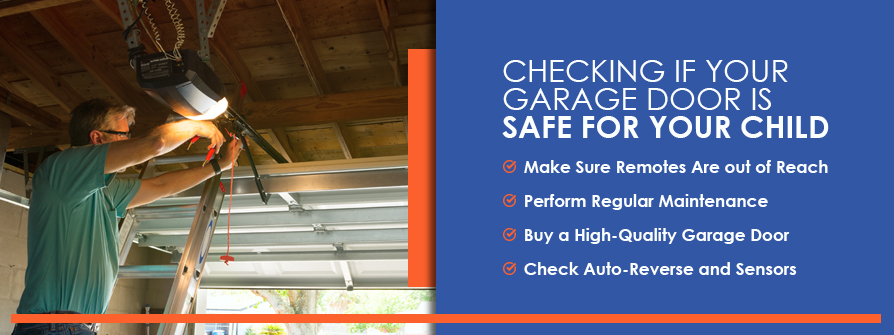
HOW TO CHECK IF YOUR GARAGE DOOR IS SAFE FOR CHILDREN
One of the biggest dangers in the garage is the door itself. These days, garage doors have sensors designed to prevent the door from coming down on top of a child, but that doesn’t mean it’s okay to let your guard down when kids are around. With proper care and inspection, you can take steps to make your garage door more child safe. Routine checks of your garage door and opener specifically are critical to keeping the door — and your child — safe. So how can you practice good garage door safety?
1. MAKE SURE GARAGE DOOR REMOTES ARE OUT OF REACH
Many homeowners have a wall panel to open their garage door when they’re coming out of the house and remotes in their vehicles to open and close their garage door when they’re pulling in or out of the driveway. All of these remotes should always be kept out of reach of children.
Why? Children love anything with buttons. They love anything that controls movement. To them, a garage door remote will probably seem like a toy. If you allow them to play with the remotes just to push buttons and watch the door go up and down, you teach them that the remotes — and the door itself — are toys. This doesn’t mean your child should never be allowed to open or close the garage door. As they get older, teach them the proper way and time to use the remotes. Allow them to open the door as you pull into the driveway, then put the remote back on your visor or wherever you keep it in the car.
The other reason to keep garage door remotes out of reach of young children is that they can open the garage door without your knowledge and end up out in the yard or, even worse, wander away from your home. Keeping remotes out of reach of young children is the equivalent to putting childproof handles on doorknobs around your home. In other words, it keeps your child contained to the areas of your home where they can safely play under your supervision.
2. PERFORM REGULAR GARAGE DOOR MAINTENANCE
Perhaps you’ve heard that the best way to remember to change the batteries in your smoke alarm is to do it twice a year when you change your clocks over for daylight savings time. This is also a good rule of thumb when it comes to performing regular checks on your garage door. Give your garage door and opener a thorough review twice a year. Check the spring, the cable, the hinges, the tracks — anything that moves when the door opens or closes. Clear away any dirt or debris that has built up around the door and grease some of the moving parts if needed. Also, look closely for cracks or dents in the door itself. While a small crack may not seem like a big deal, it can expand over time and compromise the quality of the door.
Schedule Garage Door Maintenance Today
3. BUY A HIGH-QUALITY GARAGE DOOR
The saying “you get what you pay for” applies here. Choosing the cheapest option is tempting if you’re in the market for a new garage door. You’re on a budget after all. But cheaper garage doors are made from cheaper materials, which means they may be more likely to break or malfunction. The last thing you want is to purchase a door that’s going to fail and put your family at risk.
4. CHECK AUTO-REVERSE AND SENSORS
While performing maintenance on the door and openers, closely examine the sensors on either side of your door. These sensors are designed to sense an object or person in the path of the door so it won’t close on top of something — or someone. This garage safety feature comes standard with garage door openers today, which can provide peace of mind for homeowners with young children. However, it also requires regular maintenance checks to ensure it works when needed.
Also, take a few minutes to test the auto-reverse feature by sticking a box or another object in the path of the door and then set it to close. If the door starts to come down and then reverses when it senses the box, you can be confident it’s still working. If the door crushes the box, then you may have a problem with the auto-reverse feature. If your garage door doesn’t have an automatic opener, then you won’t have an auto-reverse feature to rely on in an emergency. Consider installing a garage door opener with auto-reverse for your child’s safety and peace of mind.
HOW TO CHECK GARAGE DOOR SAFETY SENSORS
If you test the auto-reverse feature with a box, and the door fails to reverse when it detects an object underneath, then there may be an issue with the door’s safety sensors. To narrow down the source of the problem, you can check a few things on your own.
1. SENSOR ALIGNMENT
Both sensors have an LED light on their exterior. If one or both of them is blinking, their alignment must be adjusted. You can do this by tightening the screw that holds the sensor to the metal bracket attached to the wall or, in some cases, bending the bracket back into place. Once the sensors are realigned, the LED light should go off.
2. CLEAN THE LENSES
If the sensors are aligned but the doors are not engaging the auto-reverse feature — or they refuse to go down when there’s nothing in the way — then try cleaning off the lenses on each sensor. Use a soft, dry cloth to do this. Never apply water or any cleaners to the lenses.
3. MOVE DEBRIS
If the sensors are still not working, look around. Are there leaves piled up near the sensors? Perhaps someone stacked boxes too close to the lenses. If there are piles or objects near the sensors, move them and then test the door to see if the objects were simply interfering with their function.
4. DRY THE SENSORS
If all of those things still aren’t working, stop and think. Did you wash the car in the driveway or leave the garage door open during a downpour? If so, the sensors may be wet. Give them an hour or two to dry and then try closing the door again.
If you try all of these steps and your auto-reverse feature isn’t working — or your garage door won’t go down — contact a reputable garage door repair company for help!
HOW TO KEEP YOUR GARAGE SAFE
Maintaining the integrity of your garage door and its opener is only half the battle. Your garage provides a lot of opportunities for little hands to find their way into things that can hurt them even with a child-safe door. So how can a parent keep their child safe?
1. SET BOUNDARIES AND EDUCATE YOUR CHILDREN
It’s never too early to teach children to respect your garage. Don’t allow them to play with remotes or run under the door as it’s opening or closing. Don’t let them hang off of the garage door, its springs or any other mechanical parts. Set boundaries about what they can or can’t touch inside the garage. If possible, keep all of their toys, bikes and other playthings out of the garage to demonstrate to them that the garage is not a place to play. If it’s necessary to store bikes or other outdoor playthings in the garage, keep them away from the door or other potentially dangerous items in the garage. Establishing rules about being in the garage is also a good idea. For example, set the rule that your child is not allowed in the garage unless Mom or Dad is present.
2. KEEP PAINT, CHEMICALS AND TOOLS OUT OF REACH
If you’re like most people, your garage also doubles as a storage area for paint, cleaning products, gasoline for the mower and a wide variety of tools. There are a lot of things in the average garage that can draw the attention of little eyes and hands and many of them can spell danger if you aren’t careful. So how can you keep these items away from your children?
Take a close look around your garage to determine what’s there and what could pose a problem for your child. Depending on the age of the children in your house, this may vary, but, as a general rule of thumb, keep anything toxic or sharp high enough that a child can’t reach it. If you don’t already have storage bins or shelving in the garage, this is a great opportunity to clean up and clean out!
3. AVOID CLUTTER
Speaking of cleaning out the garage, keeping your space free of clutter is also important to protect children. When there’s a lot of clutter in the garage, your child could trip or stumble over stuff that’s in their way. Or, they may injure themselves by hunting around for a bike or football hidden under cords or tools that can cause harm. By organizing your garage and eliminating what you don’t need, you remove potentially dangerous items and keep your child safe.
4. KEEP VEHICLES LOCKED
If you park your car in the garage, it’s tempting to leave it unlocked. After all, who will break into your car inside the garage? Kids, that’s who! All it takes is 10 seconds for your child to walk out to the garage, climb into your unlocked car and use the remote to open the garage door. And don’t underestimate your child — even a 3-year-old can open the car door and push a button. No one wants their toddler opening the garage door and heading out into the yard or down the sidewalk to explore the neighborhood. By keeping your car locked, you eliminate the ability for your child to help themselves.
5. KEEP ALL DOORS LOCKED
Pay close attention to the door between the interior of your home and the garage. Make it a point to keep it locked to limit access to the garage. If your child is young, consider adding a child-proof handle or lock on the door as an extra measure of prevention as well. Or, if your child is tall enough — or smart enough — to get through a child-proof knob, install a heavy-duty swing bar at the top of the door to keep the door closed.
If your garage also has an exterior door, make sure to keep that door locked whenever you aren’t in the garage. That way, even if your child makes their way into the garage, they won’t be able to let themselves out of the house without you knowing. If you have a home security system, activate the feature that alerts you any time the door between your house and your garage is opened. If all other preventative measures fail, at least you’ll have immediate notice if your little one escapes!
TRUST BLANKENSHIP GARAGE DOORS
As a parent, your number one priority is your child’s safety. There are plenty of ways to limit access to the garage and keep your child safe inside it. But sometimes, you might need the help of a professional garage door sales and service company to correct a problem or replace an older garage door that has become a safety hazard. Blankenship Garage Doors has been installing and repairing garage doors since 1996 and is committed to helping families in the Pacific Northwest stay safe.
Blankenship Garage Doors offers the personalized customer service of a small repair shop, but our wide network of local contractors means you get the speed and knowledge of a large company each time you call. As a member of the International Door Association and the Central Oregon Builders Association, our goal is to provide high-quality, cost-effective service when you need it most.
When it comes to upholding garage door safety for kids, our experienced team is ready to help you identify potential danger spots and develop solutions that will protect your family. In some cases, you may need to replace a garage door or automatic opener to make this happen. If you’re in the market for a new garage door, our sales team is ready and waiting to help you choose the right door. If you’re ready to purchase a new door, you can get a free estimate today!
Have an existing garage door that needs to be repaired? Our garage door specialists can help with that too. Contact us today to schedule service.

